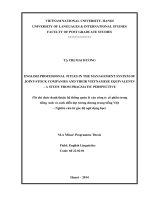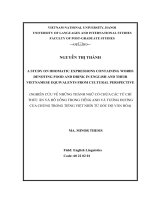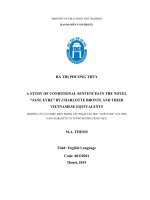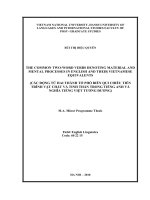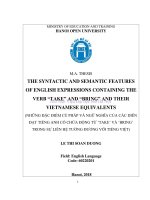THE COMMON TWO WORD VERBS DENOTING MATERIAL AND MENTAL PROCESSES IN ENGLISH AND THEIR VIETNAMESE EQUIVALENTS
Bạn đang xem bản rút gọn của tài liệu. Xem và tải ngay bản đầy đủ của tài liệu tại đây (696.2 KB, 71 trang )
VIETNAM NATIONAL UNIVERSITY, HANOI UNIVERSITY OF
LANGUAGES AND INTERNATIONAL STUDIES FACULTY OF
POST- GRADUATE STUDIES
BÙI THỊ DIỆU QUYÊN
THE COMMON TWO-WORD VERBS DENOTING MATERIAL AND
MENTAL PROCESSES IN ENGLISH AND THEIR VIETNAMESE
EQUIVALENTS
(CÁC ĐỘNG TỪ HAI THÀNH TỐ PHỔ BIẾN QUI CHIẾU TIẾN
TRÌNH VẬT CHẤT VÀ TINH THẦN TRONG TIẾNG ANH VÀ
NGHĨA TIẾNG VIỆT TƯƠNG ĐƯƠNG)
M.A. Minor Programme Thesis
Field: English Linguistics
Code: 60 22 15
HA NOI – 2010
VIETNAM NATIONAL UNIVERSITY, HANOI UNIVERSITY OF
LANGUAGES AND INTERNATIONAL STUDIES FACULTY OF
POST- GRADUATE STUDIES
BÙI THỊ DIỆU QUYÊN
THE COMMON TWO-WORD VERBS DENOTING MATERIAL AND
MENTAL PROCESSES IN ENGLISH AND THEIR VIETNAMESE
EQUIVALENTS
(CÁC ĐỘNG TỪ HAI THÀNH TỐ PHỔ BIẾN QUI CHIẾU TIẾN
TRÌNH VẬT CHẤT VÀ TINH THẦN TRONG TIẾNG ANH VÀ
NGHĨA TIẾNG VIỆT TƯƠNG ĐƯƠNG)
M.A. Minor Programme Thesis
Field: English Lingguistics
Code: 60 22 15
Supervisor: Nguyễn Thị Bích Ngọc, M.A.
HA NOI – 2010
i
DECLARATION
I certify that all the material in this study which is not my own work has been
identified and acknowledged, and that no material is included for which a degree has
already been conferred upon me.
Bui Thi Dieu Quyen
Date:
ii
Acknowledgements
First of all, I wish to express my deepest gratitude to my supervisor, Ms. Nguyen
Thi Bich Ngoc for her excellent insights and thoughtful comments throughout the study. I
am also indebted to Ph.D Tran Huu Manh for his enthusiasm and useful suggestions at the
beginning of this study.
My appreciation is also extended to all the teachers of Post-graduate departmentHULIS for lectures on language and language teaching, Ms. Ha - librarian of the
department, Ms. Nguyen Thuy, who is in charge of my class, for their administration work
and their enthusiasm.
Last but not least, I would like to send my thanks to my family and friends for their
understanding, encouragement, and support over time and distance.
iii
Abstract
English multi-word verbs are special, important and/ but difficult. They promise to
bring learners nearer to native-speakers, and simultaneously discourage patient learners by
its quantity. Scholars tackle this problem by seeking for the highest frequently used multiword verbs or finding ways of systemize them so that they become digestible for learners.
Following this direction, this study attempts to look at multi-word verbs which consist of
two elements (two-word verbs) under the light of systemic-functional grammar. Two-word
verbs of seven selected verbs are collected from dictionaries and grouped into material
processes and mental processes based on their meanings. The discrimination between PVs
and PreVs is also made.
The findings of the study though support the idea that a verb denoting one process
can have its two-word verbs belonging to different processes, also indicate that most of
those two-word verbs tend to denote the process that the single word verb denotes.
Moreover, a two-word verb of a realizing-material processes-verb can denote both material
and mental processes, but the meanings belonging to material processes are still more
prominent than those of mental processes. Besides, the meanings of a two-word verb
within one process somehow connect to one another. The study finally suggests how
learners and teachers can utilize the findings of the study to improve learning and teaching
of two-word verbs in English language education.
1
PART A: INTRODUCTION
"There is another kind of composition more frequent
in our language than perhaps in any other, from
which arises to foreigners the greatest difficulty."
----Samuel Johnson
Preface, Dictionary of the English Language, 1755
1. Rationale of the study
The two-word verbs, including phrasal verbs (PVs) and prepositional verbs
(PreVs), are an interesting linguistic phenomenon in the English language. Many English
teachers have realized the importance of this multiword knowledge in helping their
learners use English more fluently and naturally. Paradoxically, these structures are never
easy for non-native learners to acquire, mostly because the semantic, grammatical and
stylistic peculiarities that they possess.
2
The meanings of a two-word verb are not always
likely guessed from its individuals. Many non-native speakers
of English must, therefore, memorize them to be able to
understand
and use them in the right context. However,
thousands of two-word verbs and many more times of their
meanings make the massive learning unfruitful. Consequently,
Deleted: Dilin
pages are spent to find out which PVs to teach and in what
sequences. For example, Liu (2003) suggests 302 items to be
most frequently used idioms, with 104 of them are PVs.
Gardner and Davies (2007) propose a smaller number - 100
frequent PVs, which the authors claim to be a manageable
number to deal with. The problem is two-word verbs are very
polysemous, and corresponding with 100 frequent PVs proposed
by Gardner and Davies (2007), it is not 100 but up to 559
potential meanings (5.6 meanings per PV on average) learners
have to deal with.
If we focus on senses that are used more often than the
others, the load of learning English two-word verbs would be
reduced. This is also what this current study is aiming at. Biber
et al. (1999) suggest that we classify multiword verbs
according to their core meaning called semantic domains:
activity verbs, communication verbs, mental verbs,
Deleted: ,
Deleted: From this
view, the number
100 is getting less
manageable.
Deleted: What if
Deleted: ? So
3
4
causative verbs, verbs of simple occurrence, verbs of existence or relationship, and
aspectual verbs. Halliday (1985; 2004) approaches the matter with different term but the
Deleted: ,
same nature. Instead of ‘semantic domains; Halliday has term ‘processes’ (See section
1.2.1 for types of processes); and what Biber (1999) names ‘activity verb’ is labeled
‘material process’. This study uses Halliday’s terms for their clarity and systematic nature;
and attends to material and mental processes since they are considered most common by
both Halliday (1985; 2004) and Biber (1999).
Deleted: ,
2. Aims of the study
The primary aims of this paper are:
1. to study English two-word verbs, specifically distinguish two kinds of twoword verbs: PVs and PreVs;
2. to study English processes, focusing on material and mental processes;
3. to investigate some common English two-word verbs denoting material and
mental processes and find their Vietnamese equivalents;
3. Scope of the study
Deleted: <#>to suggest some
recommendations for teaching and
learning two-word verbs.¶
As far as structural aspects of two-word verbs are concerned, the current study
includes both PV (transitive and intransitive) and PreVs. ‘Phrasal-prepositional verbs’
would be beyond the scope of this paper.
Two-word verbs are rich in both number and meanings. For example, in Oxford
Phrasal verbs Dictionary, 6000 common British and American PVs are recorded; the verb
‘go’ solely has 31 two-word verbs with 209 different meanings. So, we are not ambitious
to cover all of them. Although some verbs have no single correct classification or have
multiple meanings belonging to different semantic domains, Biber (1999) affirms that
activity verbs and mental verbs are of most common. Among the 12 most common lexical
verbs that all occur over 1000 times per million words in the LSWE Corpus (Biber et al.,
1999: 373), six are activity verbs (get, go, make, come, take, give), five are mental verbs
(know, think, see, want, mean). Also by means of corpus, Biber proposes lists of the most
common lexical verbs in each semantic domain, including all verbs that occur over 300
times per million words in at least one register (cf. Biber et al., 1999: 367-369). In domain
Deleted: .
of material verbs, we see the notable common of “make, go, give, come, put”, and “take”;
Deleted: activity
while “see, think, know, want, feel, like” are distinguished representatives of mental verbs.
Therefore, having claimed to be the study of the common two-word verbs denoting
material and mental processes in English though, in the frame of a small paper, we only
focus on four outstanding representatives of material verbs: COME, GIVE, GO, MAKE
(all are in the top 10 most prolific PVs of British National Corpus), and three of mental
ones: HEAR, SEE, THINK. Moreover, only two-word verbs with idiomatic and semiidiomatic meanings used in material and mental processes are concentrated on.
4. Method of the study
The study aims to find out, in the limitation of seven lexical verbs, “how many”
and ”how often” two-word verbs belong to material and mental processes there are,
Deleted: are
comparing with the other four processes. Thus, quantitative research methods, which give
much focus on the collection and analysis of numerical data and statistics, appear to be
appropriate.
5. Design of the study
This study is designed in three parts: Introduction, Development, and Conclusion.
The Introduction gives an overview of the study. The Development consists of three
chapters: Chapter 1 - Theoretical Background, provides the fundamental concepts used in
Deleted: -
the paper; Chapter 2 - Methodology, describes thoroughly the methodology acquired in the
study; Chapter 3 presents lists of two-word combinations of seven common verbs
belonging to material and mental processes with their particles/ prepositions and their
Vietnamese equivalents. Finally, the Conclusion offers the review of the study with its
implication and application concerning teaching and learning English two-word verbs in
general.
Deleted: combination
Deleted: 8
PART B: DEVELOPMENT
CHAPTER 1: THEORETICAL BACKGROUND
This chapter represents the issues of two-word verbs and Processes of Material and
Mental in details. Section 1.1 examines some aspects of PVs and PreVs such as their
definitions and their semantic and syntactic aspects. Particles - the vital component of PVs,
Deleted: -
are also defined and classified. Section 1.2 looks into the matter of process types with the
focus is on Material and Mental processes, their definition and characteristics.
1.1. Two word verbs
Quirk et al. (1972) clarify that multi-word verbs consist of PVs, PreVs, and phrasalprepositional verbs. Biber et al. (1999: 403) add other multi-word verb constructions like V
+ noun phrase (+ preposition); V + prepositional phrase or V + V to complete the
classification of four major kinds of multi-word combinations that comprise “relatively
idiomatic units and function like single verbs”.
In this study, we focus on multi-word verbs which comprise two elements.
Though Taka (1960, cited Waibel 2007) and Meyer (1975, cited Waibel 2007) use term
“two-word verb” to mean PV, and Celce-Murcia et al. (1999) note that PVs are
sometimes called two- word verbs, both PVs and PreVs are taken into consideration when we
refer to two-word verbs.
1.1.1 Definition of PVs and PreVs
1.1.1.1 PVs
There is a disputation as to how PVs are defined. Following here are some ways of
defining PVs:
Deleted: )
Dixon, R.M.W (1991: 274) says: “Phrasal verb is a combination of verb plus
preposition that has a meaning not inferable from the individual meanings of verb and
1
preposition(s)” .
1
It is noted that the author mentions to prepositions, but particles. There is possibility that the so-call PreVs
by most of linguists is defined by Dixon as PVs, or he uses the name PVs to refer to both.
Biber et al., (1999: 403) assert: “PVs are multi-word
units
consisting of a verb followed by an adverbial particle” which all have
spatial
or
locative
meanings
Deleted:
et al.
Deleted: )
and “commonly used with extended
meanings”.
Halliday (1985: 207; 2004: 351) sees PVs as “lexical verbs which
Deleted:
see
consist of more than just the verb word itself”, which can be verb + adverb,
verb + preposition, and verb + adverb + preposition. David (2002) seems to
meet Halliday when this author insists the existence of two definitions of
PVs, the broad sense and the narrow sense. The broad sense includes both
PreVs and PVs, spatial or figurative, transitive or intransitive while
the narrow sense excludes PreVs. This study prefers looking at PV from its
narrow sense.
Before turning to PreVs, it is necessary to clarify that the term
‘phrasal verb’ is not favored by all linguistics. Said as Waibel (2007: 15),
“the very name for this type of verb is controversial”. For example, Fraser
(1947) calls it “verb-particle combination”, Zandvoort (1962) talks about
it as “verb-adverb combination”, Live (1965) “discontinuous verb”,
Lipka (1992) labels them “verb-particle construction”, Francis (1958)
“separable verb”, etc. However, Mc Arthur (1989: 38, cited Waibel,
2007: 15) notes that “the term ‘phrasal verb’ appears (…) to be the
winning term”, and Rot (1988: 183, cited David, 2002: 112) remarks that
the term PV is the most appropriate for verb-particle combinations because
“it expresses the linguistic essence of this lexical-grammar collocation, and
it has its terminological parallels in the location ‘phrasal prepositions’ ”.
And the term familiar with both teachers and students is also used in this
study.
Deleted:
G.
1.1.1.2 PreVs
About PreVs, the matter of term and definition is less controversial
than that of PVs. Scholars seem to be satisfied with the term ‘PreV’, which
refers to the kind of verb that “consists of a verb followed by a preposition”
(Biber et al., 1999: 403) and that “forms a semantic and syntactic unit”
(Leech, 1992: 264). The problem, if it has, is whether or not to see PreV as
a subtype of PV or an independent kind of verb from PV. This study
would like to look at PreV as an independent item that exists parallel with
PV.
Deleted:
exist
1.1.1.3 Particles
1.1.1.3.1 Definition and classification
The term ‘particle’ refers to a word that has a grammatical function but does not fit
into the main parts of speech like noun, verb, or adverb, etc. (Longman Dictionary of
Applied Linguistics, 1985). The exact status of the particle is still being debated; scholars
are being divided on whether it is an adverb, preposition, postpositional prefix, special part
of speech, etc. Encyclopedia Wikipedia (2010) provides seven types of word serving as
particle: ‘Articles’ (the), ‘Infinitival’ (to), ‘Preposition’ (in, on), ‘Adverbial particles’ (off,
down), ‘Interjections‘(oh, wow), ‘Sentence connectors’ (so, well), Tags (…, did they?) and
‘Conjunctions’ (and, or, nor). However, dictionaries like Longman Dictionary of
Contemporary English (2006) or MacMillan Phrasal Verbs Plus (2005) just consider
adverbs and prepositions to be particle; and some scholars (e.g. Celce-Murcia, 1999; Quirk
2
et al., 1985) even narrow term particles to adverbs . In this study, particles are also seen in
its adverbial nature and some differences between particles and prepositions will be noted
in section 1.1.1.3.3.
1.1.1.3.2 Characteristics of particles
Particles are typically found in PVs where most of them are place adjucts or can
function as such (Quirk & Greenbaum, 1973). Particles form cohesive units with verbs and
normally cannot be separated from the verb by another adverb. Moreover, they play an
important role in complementation by completing the meaning of the head-phrase, and
creating a dominant conceptual meaning for PVs.
Particles have pragmatic meaning and obviously have impact on the meaning of the
verb they follows even if the meanings of the verb are not necessary destroyed or lost.
Briton (1988: 4, cited David, 2002: 127) claims that the addition of a particle to a verb
produces the following three meanings: perfective meaning (drink up, calm down, wait out,
While Celce-Murcia (1999) explains the author’s selection is to show the close association of particle
with the verb, and to distinguish it from preposition as well as other adverbs, other scholars who consider
solely adverbs to be particles argue, “particles are commonly treated either as adverbs or else assigned to a
special class” because of their distinct behaviour, especially their variable position and the lack of an object
of their own (Langacker, 1987: 243, cited David, 2002: 125).
2
Deleted: ,
Deleted: .
die off, put over), ingressive meaning (doze off, go away, set out), or continuative/iterative
meaning (drive on, hammer away). (See aspectual PVs, section 1.1.2.1)
1.1.1.3.3 Particles vs. prepositions
Particles look like prepositions and actually have some common features with
prepositions. Both of them are invariable in form, i.e. they do not change their form in
accordance with words they accompany. Particles can sometimes be considered a special
3
type of prepositions , but they are still distinctive terms. Certain syntactic features separate
them from each other. A great deal of differences is about their position, the sentence
4
5
constituents they are linked to , and their function , etc. Moreover, particles usually affect
the meanings of their proceeding verbs while prepositions usually do not and even
independent of them. (See section 1.1.2.3.1).
To separate adverbial particles from prepositions, objects might be helpful. As
Swan (1980: 95, cited David, 2002: 115) points out, prepositions must have objects while
adverbs particle need not. Celce-Murcia (1999: 429) proposes syntactic tests (adopted from
O’Dowd, 1994: 19) to set apart particles and prepositions. Accordingly,
Only prepositions allow:
Adverb insertion (e.g. We turned quickly off the road, but not we turned
quickly off the light)
Phrase fronting (e.g. Up the hill John ran, not Up the bill John ran)
Wh-fronting (e.g. About what does he write?, not Up what does he write?)
Only particles in separable PVs allow:
Passivization (e.g. The light was turned off, not The road was turned out)
Verb substitution (e.g. The light was extinguished (= turned off))
NP insertion (e.g. We turned the light off, not We turned the road off )
Many words can be used both as adverbs and prepositions except back and away
(they are only adverb), while other words like from and during can only be treated as
prepositions (David, 2002: 115- 116).
4
A preposition denotes a semantic relationship between two entities as to place, time,
instrument or cause etc
(Quirk et al., 1972) while a particle is part of the verb.
5
Adverbial particles function as adverbs and modify the preceding verb.
3
Deleted:
.
1.1.2 Syntactic and semantic characteristics of PVs and PreVs
2.1.2.1 Syntactic and semantic characteristics of PVs
Regarding syntactical aspects of PVs, PVs’ subcategories and PVs’ separation need
to be dealt with. In MacMillan Phrasal Verb Plus by Rundell and Fox (2005), PVs are
divided into three types: transitive, intransitive, and those which is both transitive and
intransitive. But it seems to be simpler to set PVs into intransitive and transitive like the
way Quirk and Greenbaum (1973), Biber et al. (1999), or Celce-Murcia et al. (1999) do;
noting that some combinations can have “dual function” (Celce-Murcia et al., 1999: 427),
i.e., they can be either transitive or intransitive, with or without a difference of meaning
(Quirk & Greenbaum, 1973). Most of the challenge is assumed to fall into transitive PVs
because of its peculiar syntactic characteristic, its separability. As Celce-Murcia (1999)
puts it, in spite of being part of the PV, particle does not have to be adjacent with it. Listed
here are three subcategories of separation:
The largest, most productive category is optional separable PV, where
particle can stand either before of after direct object except when the direct
6
object is a pronoun .
E.g. put on = wear: Anne put on her coat and went out.
or Anne put her coat on and went out.
The smaller category is inseparable phrasal verb. In this kind, the particle
7
is forced to follow right after the verb .
E.g. I came on (= encounter) this beautiful vase in the attic.
Sometimes, the separation is obligatory and we will name this obligatory
8
separable PV. In this kind, the particles are always separated .
E.g. put through = test: We put the machines through a series of tests.
6
If the direct object is not a pronoun or if it is a long and complicate noun phrase, it would prefer the position
after the particle or as (Celce-Murcia, 1999: 435) put it, “the conventional position for new, discourse salient
information”. The insertion of complex noun phrase between verb and the particle is believed to interrupt the
cognitive unity of the verb and particle and make it difficult to understand.
7
Celce-Murcia (1999) said this phenomenon is because what we are calling a particle is actually a
preposition and thus would naturally go before its object
8
The obligatory separation is presumed to avoid the ambiguity with the inseparable phrasal verbs, which
have the same form but different meaning (Celce-Murcia et al., 1999).
Deleted: .
From semantic view, we see three important aspects: the polysemy, productivity,
and idiomaticity.
Like single-word verbs, PVs are polysemous in that one form of PVs can have
various meaning, and simultaneously, one meaning can also be expressed by more than
Deleted:
semantical
Formatted: Indent: First
line:
0.49", Space Before: 6 pt,
After: 6 pt
Formatted:
0.49"
Indent: First
Deleted:
(431),
”
line:
9
one form. Additionally, English continually generates new PVs as well as new meanings
of existed PVs. Celce-Murcia (1999: 431) describes PV as “a highly productive lexical
category in English”, while Bolinger (1974: xi, cited Celce-Murcia, 1999) comments the
phenomenon as “an outpouring of lexical creativeness that surpasses anything else in our
language”. Explaining the popularity of PVs in English, Bolinger (1971: xii, cited
Stephens, 2008) said,
"They are words. The everyday inventor is not required to reach for elements
such as roots and affixes that have no reality for him. It takes only a rough
familiarity with other uses of head and off to make them available for head off,
virtually self-suggesting when the occasion for them comes up, which is not
Formatted:
Indent:
Left:
0.78", Space After:
1 line,
Line spacing: Exactly 19 pt
true of learned formations like intercept".
Yet it seems impossible to know exactly which verb will join with which particle to
Deleted:
(xii).
form a new PV. There usually needs a semantic coordination between verbs and particles.
In other words, verbs limit their choice of adverbial particle by their semantic content.
Deleted:
t
Nevertheless, it does not mean PVs cannot be systematized. Supported by the idea that the
semantic of PVs is not as “arbitrary” as it is often held to be (Smclair, Moon et al., 1939,
cited David, 2002), Celce-Murcia (1999) claims the existence of some systemeticity in
how meaning is represented in PVs; and to understand that systematicity, we familiarize
ourselves with three semantic categories of PVs: literal, aspectual, and idiomatic (See
Deleted:
.
Quirk et al., 1972, Celce-Murcia et al., 1999)
Literal PVs: comprise a verb and a directional preposition, function
syntactically like verb-particle constructions, except that particle keeps its
Deleted:
.
Deleted:
.
Mc Arthur and Atkins (1974: 6, cited David, 2002: 128) claim 6 types of verbs that can be phrasalized,
including: a/ verbs of movement (go, come); b/ verbs of invitation and ordering (invite, let); c/ the so-called
‘empty verb’, verbs of indefinite meaning (get, make); d/ verbs formed with or without the suffix –en, from
simple monosyllabic adjectives (brighten); e/ verbs formed unchanged from simple, usually monosyllabic
nouns with such paraphrase patterns as chalk up = mark up with chalk; f/ a random scattering of two-syllable
verbs of Latin origin, with which some kind of direction or emphasis is required (measure (up), level (off)).
9
"
prepositional meaning and the result is a PV whose meaning is fully
compositional. (e.g. sit down).
10
Aspectual PVs : certain particles can add consistent aspectual meaning to
the verb without changing the origin meaning of that verb. Thus, the
meaning of the whole is neither literal nor idiomatic. For Celce-Murcia
Deleted: As
(1999: 432- 433), four main types of aspectual PVs are distinguished:
- Inceptive PVs (signal a beginning state): take off, set out, start up
- Continuative: (show that the action continues) Activity verbs + on/
along (come along, keep on), away (sleep away), around (mess around),
through ( think through)
- Iterative PVs (activity verbs + over show repetition ): think over
- Completive PVs (show complete action with up, out, off and down):
wear out, mix up, cut off, check over, etc
Idiomatic PVs: are those that we cannot infer their meaning from their
11
components . For instance, in the sentence I hope you will get over your
operation quickly, the literal meaning of ‘get over’, in sense of ‘to climb
Formatted: Indent: Left: 0.68",
Hanging: 0.29", Bulleted +
Level: 1
+ Aligned at: 0.25" + Tab after:
0.5" + Indent at: 0.5", Tabs: Not
at
0.5"
over st to get to the other side’ no longer applies to explain the subject’s
enduring an operation.
2.1.2.2 Syntactic and semantic characteristics of PreVs
Syntactically, PreVs always has its preposition followed by a nominal object (Biber
et al. 1999). They, however, do not coincide with inseparable transitive PVs because the
object still follows the preposition when it is a pronoun. Moreover, the verb can have its
own object which usually precedes the preposition. Two structural patterns for PreVs are:
V + preposition + NP
E.g. I’ve never ever thought about [it]
Formatted: Indent: Left:
1.5", Bulleted + Level: 3 +
Aligned at:
1.25" + Tab after: 1.5" + Indent
at:
1.5", Tabs: 1.75", List tab + Not
at
1.5"
Formatted: Indent: Left: 1.75"
10
Some authors suggest grouping PVs based on the particle instead of the verb element as we usually do. We
think it is applicable for aspectual PVs only. Moreover, aspectual particles do not go with every verb. Certain
aspectual particles co-occur with certain verbs. That is why we have fade out but do not accept fade up.
11
The meaning of this kind is believed to have relation with underlying logic of the language and cultural
traditions. Langacker (1991, cited David, 2002) defend that the vast majority PVs rely at least in part on the
literal or aspectual meaning of the particle and thus they can help to figure out figurative meaning.




